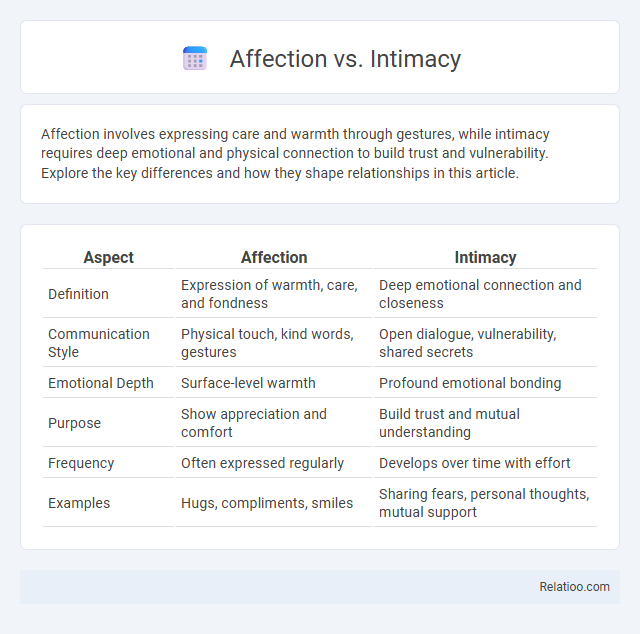Affection involves expressing care and warmth through gestures, while intimacy requires deep emotional and physical connection to build trust and vulnerability. Explore the key differences and how they shape relationships in this article.
Table of Comparison
| Aspect | Affection | Intimacy |
|---|---|---|
| Definition | Expression of warmth, care, and fondness | Deep emotional connection and closeness |
| Communication Style | Physical touch, kind words, gestures | Open dialogue, vulnerability, shared secrets |
| Emotional Depth | Surface-level warmth | Profound emotional bonding |
| Purpose | Show appreciation and comfort | Build trust and mutual understanding |
| Frequency | Often expressed regularly | Develops over time with effort |
| Examples | Hugs, compliments, smiles | Sharing fears, personal thoughts, mutual support |
Understanding Affection: Definition and Key Traits
Understanding affection involves recognizing it as a warm, gentle feeling of fondness and care toward someone, often expressed through physical touch, kind words, or thoughtful actions. Key traits of affection include emotional warmth, a desire to show closeness, and a sense of comfort and security in the relationship. Unlike intimacy, which requires deeper emotional or physical closeness, affection can be present in various types of relationships and serves as a foundation for bonding.
What is Intimacy? Exploring Its Core Elements
Intimacy is a deep emotional connection characterized by trust, vulnerability, and mutual understanding between individuals. Core elements include emotional closeness, open communication, and shared experiences that foster a sense of security and bonding. Unlike affection, which involves expressions of love or fondness, intimacy requires a sustained commitment to genuine emotional engagement and support.
Affection vs Intimacy: Key Differences Explained
Affection involves outward expressions of care, such as hugs, smiles, and verbal affirmations, which convey warmth and fondness toward others. Intimacy goes deeper, encompassing emotional closeness, vulnerability, and a strong sense of trust that fosters profound connection beyond physical gestures. Unlike affection, intimacy requires sustained emotional sharing and mutual understanding to build and maintain meaningful relationships.
Emotional Connection: How Affection and Intimacy Interact
Emotional connection deepens through both affection and intimacy, where affection involves expressing warmth and care, while intimacy encompasses sharing vulnerable thoughts and feelings. Affection fosters trust and comfort, creating a foundation for intimacy to develop into a profound emotional bond. This dynamic interplay enhances relationship satisfaction by blending physical gestures with emotional openness.
Physical Expressions: Hugs, Kisses, and Beyond
Physical expressions of affection include hugs, kisses, and gentle touches, which convey warmth and care without necessarily implying deep emotional intimacy. Intimacy extends beyond these gestures, involving a profound emotional connection that fosters vulnerability and trust between individuals. While affection can be expressed through brief physical contact, intimacy often manifests in sustained, meaningful interactions that deepen relational bonds.
The Role of Trust in Affection and Intimacy
Trust serves as the foundation that distinguishes affection from intimacy by fostering emotional safety and vulnerability. While affection involves expressions of warmth and care, intimacy requires deeper trust to share personal thoughts and feelings. Building your trust strengthens the bond, transforming affectionate gestures into meaningful, intimate connections.
Affection in Friendships vs Intimacy in Relationships
Affection in friendships involves expressing care through gestures like thoughtful words, physical touch, or acts of kindness, which strengthens emotional bonds without romantic expectations. Intimacy in relationships goes deeper by combining emotional closeness, vulnerability, and shared experiences, creating a unique connection that often includes romantic or physical elements. Understanding these differences helps you nurture each type of connection appropriately, fostering trust and support in friendships while cultivating deeper emotional ties in romantic relationships.
How Culture Shapes Affection and Intimacy
Cultural norms profoundly influence how affection and intimacy are expressed and perceived, shaping your social interactions and emotional bonds. In collectivist societies, affection may be demonstrated through communal activities and family obligations, while individualistic cultures often prioritize verbal affirmations and physical closeness to signify intimacy. Understanding these cultural variations enhances your ability to navigate relationships across diverse backgrounds effectively.
Common Misconceptions About Affection and Intimacy
Affection and intimacy are often mistaken as identical, but affection refers to visible expressions of love or care, while intimacy involves a deeper emotional or physical connection. Many believe affection always signifies intimacy, but you can show affection without establishing intimate bonds. Understanding these distinctions helps clarify your relationships and prevents common misinterpretations of emotional closeness.
Building Stronger Bonds: Balancing Affection and Intimacy
Building stronger bonds requires a balanced blend of affection and intimacy, where affection provides expressions of love through gestures and touch, while intimacy fosters deep emotional connection and trust. Affection acts as the visible, tangible aspect of care, whereas intimacy involves vulnerability and shared personal experiences that create lasting closeness. Prioritizing both elements equally enhances relationship satisfaction and supports enduring emotional bonds.

Infographic: Affection vs Intimacy
 relatioo.com
relatioo.com